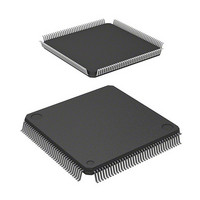R4F24269NVFQV Renesas Electronics America, R4F24269NVFQV Datasheet - Page 1018

R4F24269NVFQV
Manufacturer Part Number
R4F24269NVFQV
Description
MCU 256KB FLASH 64K 144-LQFP
Manufacturer
Renesas Electronics America
Series
H8® H8S/2400r
Datasheet
1.R4F24268NVZFQV.pdf
(1406 pages)
Specifications of R4F24269NVFQV
Core Processor
H8S/2600
Core Size
16/32-Bit
Speed
33MHz
Connectivity
EBI/EMI, I²C, IrDA, SCI, SSU, UART/USART
Peripherals
DMA, POR, PWM, WDT
Number Of I /o
96
Program Memory Size
256KB (256K x 8)
Program Memory Type
FLASH
Ram Size
64K x 8
Voltage - Supply (vcc/vdd)
3 V ~ 3.6 V
Data Converters
A/D 10x10b, D/A 2x8b
Oscillator Type
External
Operating Temperature
-20°C ~ 75°C
Package / Case
144-LQFP
Lead Free Status / RoHS Status
Lead free / RoHS Compliant
Eeprom Size
-
Available stocks
Company
Part Number
Manufacturer
Quantity
Price
Company:
Part Number:
R4F24269NVFQV
Manufacturer:
Renesas Electronics America
Quantity:
135
Company:
Part Number:
R4F24269NVFQV
Manufacturer:
Renesas Electronics America
Quantity:
10 000
- Current page: 1018 of 1406
- Download datasheet (9Mb)
Section 16 I2C Bus Interface 2 (IIC2)
16.7
1. Issue (retransmit) the start/stop conditions after the fall of the ninth clock is confirmed.
2. Control WAIT in the I
3. In slave receive mode, even if a slave address does not match, received data is stored in
4. If 0 is written to the ICE bit in ICCRA or 1 is written to the IICRST bit in ICCRB in one of the
Page 988 of 1372
Check SCLO in the I
When the start/stop conditions are issued (retransmitted) at the specific timing under the
following condition (i) or (ii), such conditions may not be output successfully. This does not
occur in other cases.
(i) When the rising of SCL falls behind the time specified in section 16.6, Bit Synchronous
(ii) When the bit synchronous circuit is activated by extending the low period of eighth and
When WAIT is set to 1, and SCL is driven low for two or more transfer clocks by the slave
device at the eighth and ninth clocks, the high period of ninth clock may be shortened. This
does not occur in other cases.
ICDRR, and then the RDRF bit in ICSR is set. To confirm whether or not the addresses
matched, see the AAS bit in the I2C bus status register (ICSR). (See figure 16.17, Sample
Flowchart for Slave Receive Mode.)
following four states, the BBSY bit in ICCRB and STOP bit in ICSR are undefined.
(1) This module is the bus master of the I2C in master transmission mode (MST = 1 and TRS
(2) This module is the bus master of the I2C in master reception mode (MST = 1 and TRS = 0
(3) This module is transmitting data in slave transmission mode (MST = 0 and TRS = 1 in
(4) This module is transmitting an acknowledgment in slave reception mode (MST = 0 and
The undefined state of BBSY in ICCRB can be exited in one of the following ways:
⎯ Input the start condition (SCL = high and SDA falling) to set BBSY to 1.
⎯ Input the stop condition (SCL = high and SDA rising) to clear BBSY to 0.
⎯ Write 1 to BBSY and 0 to SCP in ICCRB to issue the start condition with SCL = high and
Circuit, by the load of the SCL bus (load capacitance or pull-up resistance)
ninth clocks, that is driven by the slave device
= 1 in ICCRA).
in ICCRA).
ICCRA).
TRS = 0 in ICCRA).
SDA = high in master transmission mode. BBSY is set to 1 when the start condition (SCL
= high and SDA falling) is output.
Usage Notes
2
C control register B (IICRB) to confirm the fall of the ninth clock.
2
C bus mode register (ICMR) to be set to 0.
H8S/2426, H8S/2426R, H8S/2424 Group
REJ09B0466-0350 Rev. 3.50
Jul 09, 2010
Related parts for R4F24269NVFQV
Image
Part Number
Description
Manufacturer
Datasheet
Request
R

Part Number:
Description:
KIT STARTER FOR M16C/29
Manufacturer:
Renesas Electronics America
Datasheet:

Part Number:
Description:
KIT STARTER FOR R8C/2D
Manufacturer:
Renesas Electronics America
Datasheet:

Part Number:
Description:
R0K33062P STARTER KIT
Manufacturer:
Renesas Electronics America
Datasheet:

Part Number:
Description:
KIT STARTER FOR R8C/23 E8A
Manufacturer:
Renesas Electronics America
Datasheet:

Part Number:
Description:
KIT STARTER FOR R8C/25
Manufacturer:
Renesas Electronics America
Datasheet:

Part Number:
Description:
KIT STARTER H8S2456 SHARPE DSPLY
Manufacturer:
Renesas Electronics America
Datasheet:

Part Number:
Description:
KIT STARTER FOR R8C38C
Manufacturer:
Renesas Electronics America
Datasheet:

Part Number:
Description:
KIT STARTER FOR R8C35C
Manufacturer:
Renesas Electronics America
Datasheet:

Part Number:
Description:
KIT STARTER FOR R8CL3AC+LCD APPS
Manufacturer:
Renesas Electronics America
Datasheet:

Part Number:
Description:
KIT STARTER FOR RX610
Manufacturer:
Renesas Electronics America
Datasheet:

Part Number:
Description:
KIT STARTER FOR R32C/118
Manufacturer:
Renesas Electronics America
Datasheet:

Part Number:
Description:
KIT DEV RSK-R8C/26-29
Manufacturer:
Renesas Electronics America
Datasheet:

Part Number:
Description:
KIT STARTER FOR SH7124
Manufacturer:
Renesas Electronics America
Datasheet:

Part Number:
Description:
KIT STARTER FOR H8SX/1622
Manufacturer:
Renesas Electronics America
Datasheet:

Part Number:
Description:
KIT DEV FOR SH7203
Manufacturer:
Renesas Electronics America
Datasheet:











